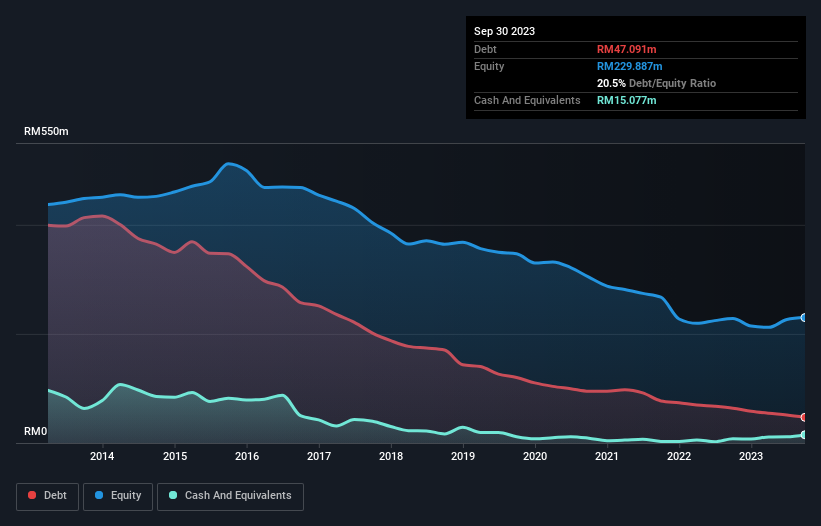Is Sealink International Berhad (KLSE:SEALINK) A Risky Investment?

Some say volatility, rather than debt, is the best way to think about risk as an investor, but Warren Buffett famously said that 'Volatility is far from synonymous with risk.' So it might be obvious that you need to consider debt, when you think about how risky any given stock is, because too much debt can sink a company. Importantly, Sealink International Berhad (KLSE:SEALINK) does carry debt. But is this debt a concern to shareholders?
When Is Debt Dangerous?
Debt assists a business until the business has trouble paying it off, either with new capital or with free cash flow. In the worst case scenario, a company can go bankrupt if it cannot pay its creditors. However, a more common (but still painful) scenario is that it has to raise new equity capital at a low price, thus permanently diluting shareholders. Having said that, the most common situation is where a company manages its debt reasonably well - and to its own advantage. When we think about a company's use of debt, we first look at cash and debt together.
View our latest analysis for Sealink International Berhad
What Is Sealink International Berhad's Debt?
As you can see below, Sealink International Berhad had RM47.1m of debt at September 2023, down from RM63.8m a year prior. However, it does have RM15.1m in cash offsetting this, leading to net debt of about RM32.0m.

How Strong Is Sealink International Berhad's Balance Sheet?
The latest balance sheet data shows that Sealink International Berhad had liabilities of RM84.0m due within a year, and liabilities of RM27.2m falling due after that. Offsetting this, it had RM15.1m in cash and RM30.5m in receivables that were due within 12 months. So its liabilities total RM65.6m more than the combination of its cash and short-term receivables.
This deficit is considerable relative to its market capitalization of RM90.0m, so it does suggest shareholders should keep an eye on Sealink International Berhad's use of debt. Should its lenders demand that it shore up the balance sheet, shareholders would likely face severe dilution. There's no doubt that we learn most about debt from the balance sheet. But you can't view debt in total isolation; since Sealink International Berhad will need earnings to service that debt. So if you're keen to discover more about its earnings, it might be worth checking out this graph of its long term earnings trend.
In the last year Sealink International Berhad wasn't profitable at an EBIT level, but managed to grow its revenue by 85%, to RM100m. With any luck the company will be able to grow its way to profitability.
Caveat Emptor
While we can certainly appreciate Sealink International Berhad's revenue growth, its earnings before interest and tax (EBIT) loss is not ideal. Indeed, it lost RM1.5m at the EBIT level. When we look at that and recall the liabilities on its balance sheet, relative to cash, it seems unwise to us for the company to have any debt. So we think its balance sheet is a little strained, though not beyond repair. We would feel better if it turned its trailing twelve month loss of RM6.2m into a profit. In the meantime, we consider the stock very risky. The balance sheet is clearly the area to focus on when you are analysing debt. But ultimately, every company can contain risks that exist outside of the balance sheet. To that end, you should learn about the 3 warning signs we've spotted with Sealink International Berhad (including 2 which are potentially serious) .
Of course, if you're the type of investor who prefers buying stocks without the burden of debt, then don't hesitate to discover our exclusive list of net cash growth stocks, today.
If you're looking to trade Sealink International Berhad, open an account with the lowest-cost platform trusted by professionals, Interactive Brokers.
With clients in over 200 countries and territories, and access to 160 markets, IBKR lets you trade stocks, options, futures, forex, bonds and funds from a single integrated account.
Enjoy no hidden fees, no account minimums, and FX conversion rates as low as 0.03%, far better than what most brokers offer.
Sponsored ContentNew: Manage All Your Stock Portfolios in One Place
We've created the ultimate portfolio companion for stock investors, and it's free.
• Connect an unlimited number of Portfolios and see your total in one currency
• Be alerted to new Warning Signs or Risks via email or mobile
• Track the Fair Value of your stocks
Have feedback on this article? Concerned about the content? Get in touch with us directly. Alternatively, email editorial-team (at) simplywallst.com.
This article by Simply Wall St is general in nature. We provide commentary based on historical data and analyst forecasts only using an unbiased methodology and our articles are not intended to be financial advice. It does not constitute a recommendation to buy or sell any stock, and does not take account of your objectives, or your financial situation. We aim to bring you long-term focused analysis driven by fundamental data. Note that our analysis may not factor in the latest price-sensitive company announcements or qualitative material. Simply Wall St has no position in any stocks mentioned.
About KLSE:SEALINK
Sealink International Berhad
An investment holding company, owns, builds, and operates a fleet of offshore marine support vessels in Malaysia, Singapore, and Vietnam.
Flawless balance sheet and good value.
Market Insights
Community Narratives



